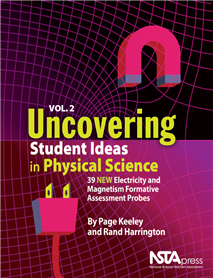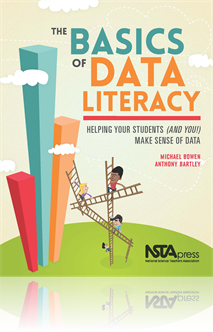All Book Chapters
Book Chapter
The purpose of this assessment probe is to elicit students’ ideas about magnetization. It is designed to find out how students would represent, at the particle level, a nonmagnetized versus a magnetized nail. The probe is best used with middle and ...
Book Chapter
How Can You Make an Electromagnet?
The purpose of this assessment probe is to elicit students’ ideas about electromagnets. It is designed to reveal where students think the magnetic effect comes from when wire is wrapped around a nail to make a magnet. The probe is best used with mi...
Book Chapter
Does the Type of Wire Make a Difference in an Electromagnet?
The purpose of this assessment probe is to elicit students’ ideas about electromagnets. The probe is designed to reveal whether students recognize that an electromagnetic effect can pass through an insulated wire. This probe is best used with middl...
Book Chapter
How Can You Make a Stronger Electromagnet?
The purpose of this assessment probe is to elicit students’ ideas about electromagnets. It is designed to reveal what variables students think affect the strength of an electromagnet. This probe is best used with middle and high school students. If...
Book Chapter
What Happens When You Bring a Compass Near a Current Carrying Wire?
The purpose of this probe is to elicit student ideas about magnetic poles. The probe is designed to reveal whether students think a magnetic field must always have magnetic poles. It is best used with high school students. If materials are available,...
Book Chapter
A Need for Speed? Should Speed Limits Be Lowered to Reduce Traffic Fatalities?
During this unit, students will investigate physical science concepts related to forces and motion. They will then synthesize and apply their learning to grapple with the question of whether speed limits should be lowered to reduce traffic accidents....
Book Chapter
Activity 5: Some Striped Seeds Seem Similar! Biology: Genetic Variation
There is a pattern in nature that appears almost every time we measure or count individuals of a species based on a specific characteristic. This activity puts students in the role of scientists as they learn about statistics and genetic variation wi...
Book Chapter
The Importance of Viable Models in the Construction of Professional Development
With the release of the Framework and the NGGS, we have the opportunity to improve the teaching and learning of science and to help move our nation forward by providing all students with the depth of understanding of big ideas, scientific and enginee...
Book Chapter
In this chapter, the authors look at three basic statistical tests. The first is the t-test, which is used when you have nominal or ordinal data and only two test variables you are comparing (e.g., the speed of cats and dogs). The second is the analy...
Book Chapter
From the Framework to the NGSS
This chapter first reviews essential features of A Framework for K–12 Science Education which provides a foundation for the Next Generation Science Standards (NGSS). Second, the chapter describes the important features of NGSS and introduces the N...
Book Chapter
NGSS: 10 Frequently Answered Questions
This chapter provides answers to frequently asked and answered questions. It comes as no surprise that the questions science teachers ask have to do with the changes implied by NGSS and the changes required in classroom practices. The ultimate benef...
Book Chapter
From NGSS to Instruction in an Elementary Classroom
Implementing the standards does present significant challenges—the obvious and immediate challenge of classroom instruction. There also is the long-term challenge of contributing to students’ progressive understanding across the K–12 curriculum...
Book Chapter
From NGSS to Instruction in a Middle School Classroom
For middle school science teachers, one of the most fundamental changes involves curriculum, instruction, and assessments. This chapter uses performance expectations from the life sciences as the basis for a description of how Next Generation Science...
Book Chapter
From NGSS to Instruction in a High School Classroom
This chapter first presents performance expectations that describe the competencies and content for instruction and assessment in a high school biology class. This is followed by a description of a teaching sequence that integrates the practices, cor...
Book Chapter
The general purpose of education standards is to reset the goals for education, then make curriculum programs, classroom instruction, and education assessments more coherent through processes of reform. So, we have to begin as soon as possible (ASAP)...







